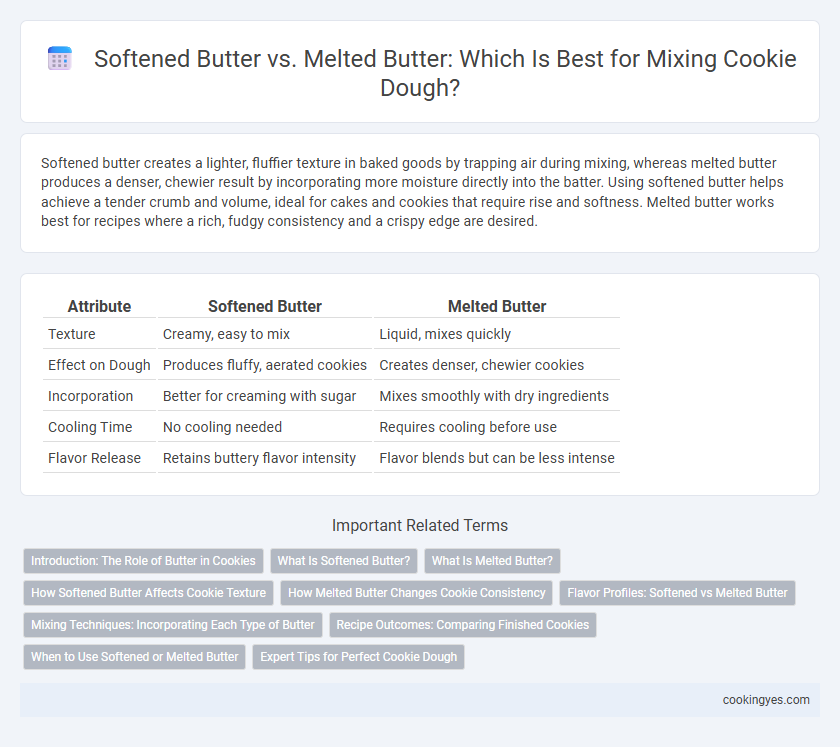Softened butter creates a lighter, fluffier texture in baked goods by trapping air during mixing, whereas melted butter produces a denser, chewier result by incorporating more moisture directly into the batter. Using softened butter helps achieve a tender crumb and volume, ideal for cakes and cookies that require rise and softness. Melted butter works best for recipes where a rich, fudgy consistency and a crispy edge are desired.
Table of Comparison
| Attribute | Softened Butter | Melted Butter |
|---|---|---|
| Texture | Creamy, easy to mix | Liquid, mixes quickly |
| Effect on Dough | Produces fluffy, aerated cookies | Creates denser, chewier cookies |
| Incorporation | Better for creaming with sugar | Mixes smoothly with dry ingredients |
| Cooling Time | No cooling needed | Requires cooling before use |
| Flavor Release | Retains buttery flavor intensity | Flavor blends but can be less intense |
Introduction: The Role of Butter in Cookies
Butter plays a crucial role in cookie texture by influencing moisture, spread, and flavor. Softened butter incorporates air when creamed with sugar, creating a light and tender crumb, while melted butter results in denser, chewier cookies due to its liquid state. Choosing between softened and melted butter affects the cookie's structure, with softened butter yielding fluffier cookies and melted butter producing a fudgier consistency.
What Is Softened Butter?
Softened butter refers to butter that has been left at room temperature until it reaches a pliable, spreadable consistency without losing its shape, which is essential for proper creaming with sugar in cookie recipes. Unlike melted butter, softened butter traps air during mixing, creating a lighter, fluffier dough that yields tender and chewy cookies. Properly softened butter ensures even incorporation of ingredients, enhancing texture and flavor in baked cookies.
What Is Melted Butter?
Melted butter is butter that has been heated until fully liquefied, usually at a low temperature to avoid browning. In cookie recipes, melted butter creates a denser, chewier texture by allowing better integration with sugar and flour. This state of butter contributes to a richer mouthfeel and can enhance the cookie's overall moisture and flavor intensity.
How Softened Butter Affects Cookie Texture
Softened butter incorporates air during mixing, creating a lighter, fluffier cookie texture with a tender crumb and subtle rise. This method enhances moisture retention, resulting in chewier, more evenly baked cookies compared to melted butter, which tends to produce denser, crisper outcomes. Choosing softened butter optimizes dough aeration, directly influencing the softness and overall mouthfeel of the finished cookie.
How Melted Butter Changes Cookie Consistency
Melted butter increases cookie spread and produces a denser, chewier texture due to its liquid form blending more thoroughly with sugars and flours. Unlike softened butter, which incorporates air and creates fluffier dough, melted butter dissolves sugar more effectively, resulting in a crisper edge and moist center. This change in fat state significantly alters cookie structure, making cookies thinner and more uniform in texture.
Flavor Profiles: Softened vs Melted Butter
Softened butter retains its creamy texture, allowing for better aeration when creamed with sugar, which enhances the cookie's lightness and rich, buttery flavor. Melted butter, by contrast, integrates more thoroughly into the dough, producing denser cookies with a more pronounced caramelized taste due to increased sugar browning. The choice between softened and melted butter significantly influences the cookie's texture and flavor profile, with softened butter yielding a fluffier crumb and melted butter delivering a chewier, deeper flavor.
Mixing Techniques: Incorporating Each Type of Butter
Softened butter incorporates air when creamed with sugar, creating a light, fluffy dough that yields tender, cakey cookies. Melted butter mixes smoothly with dry ingredients, producing a denser, chewier texture ideal for chewy or fudgy cookies. Selecting the appropriate butter state and mixing technique directly influences cookie spread, texture, and crumb structure.
Recipe Outcomes: Comparing Finished Cookies
Softened butter creates cookies with a thicker, chewier texture due to its ability to hold air when creamed, enhancing rise and structure. Melted butter produces denser, flatter cookies with a crisper edge, as the fat fully liquefies and incorporates differently within the dough. Recipes utilizing softened butter tend to yield a more uniform crumb, while melted butter results in a chewier, more brittle bite.
When to Use Softened or Melted Butter
Softened butter is ideal for creaming with sugar to incorporate air, creating a light and fluffy cookie texture, essential in recipes like chocolate chip or sugar cookies. Melted butter, by contrast, integrates more readily into the dough, resulting in denser, chewier cookies such as brownies or peanut butter cookies. Choosing between softened and melted butter depends on the desired cookie texture and the recipe's mixing method.
Expert Tips for Perfect Cookie Dough
Softened butter provides structure and aeration in cookie dough, resulting in a tender, chewy texture, while melted butter increases spread and creates a denser, crisper cookie. Expert bakers recommend creaming softened butter with sugar to incorporate air, enhancing the dough's rise and softness. Using melted butter is ideal for recipes aiming for thin, fudgy cookies, but softened butter ensures controlled consistency and optimal flavor development.
Softened butter vs Melted butter for mixing Infographic

 cookingyes.com
cookingyes.com